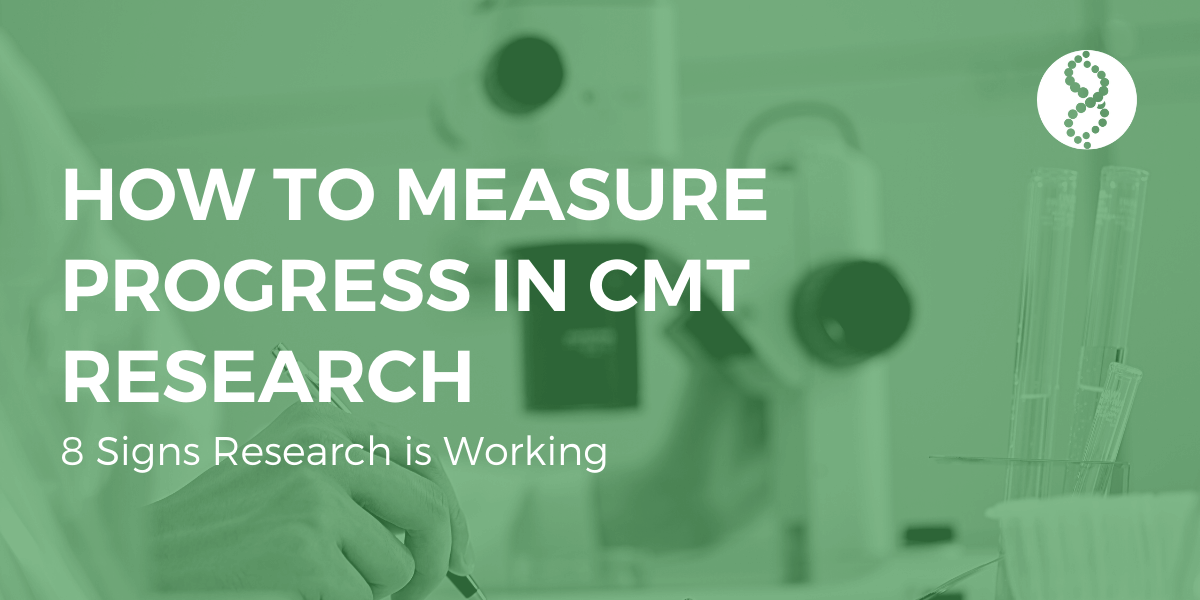By: Susan Ruediger, CEO, CMT Research Foundation
It costs more than $2.6 billion to develop an approved prescription medicine (Journal of Health Economics, 2016) and typically takes between 10 to 15 years to get a drug to clinical trials (Neuron, 2014). With no treatments or cures currently available for diseases like Charcot-Marie-Tooth, it’s easy to question how donations to support scientific research really make a difference. The good news is, there are important ways to measure progress in CMT research as scientists and nonprofits like the CMT Research Foundation work to deliver treatments and cures.
Here are eight ways to measure progress in CMT research and know when projects like those funded by the CMT Research Foundation are working.

1. Patents are filed.
An academic institution typically only goes through the financial expense and laborious task of filing a patent for their intellectual property (IP) if there is strong evidence that a candidate treatment could be viable for patients and families.
2. Industry tries to acquire or license a therapeutic approach or technology from researchers who are conducting early work.
After patents are filed, industry partners (small biotech or large pharmaceutical companies) start inquiring about procuring the candidate treatment or a license to develop and sell it. Industry only risks the initial investment to license a candidate treatment from a university or biotech company if they believe it can be lucrative for them.
3. Industry partners prepare for clinical trials.
When industry partners express a desire to develop a pathway to clinical trials, it’s a clear sign of optimism for the potential treatment. Designing and carrying out clinical trials is a significant undertaking, requiring an enormous investment of time and resources.
4. Outside funding is supporting the initiative.
Significant capital for research projects often comes from either venture capital firms or big pharmaceutical companies. Companies assume higher risks at this stage and usually develop a diverse portfolio to mitigate the risks, but it’s a good sign that the technology is moving in the right direction.
5. Researchers publish their results in scientific and medical journals.
Significant scientific discoveries warrant broad publication. When a journal accepts a paper for publication, a researcher knows he or she has made a discovery worthy of being part of the scientific record and contributing to the overall body of knowledge. In fact, scientists highlight the number of published papers as a measure of their scientific productivity. Publication also spurs other scientists to follow up on research with experiments of their own, opening the field to advance new discoveries.
6. INDs are filed.
An Investigational New Drug (IND) application is when a pharmaceutical company obtains permission from the Food and Drug Administration (FDA) to start human clinical trials. At this point, safety and efficacy have been tested in animal studies, the manufacturing process of the drug has been determined, and the clinical protocols are understood. When a company meets with the FDA to discuss an IND application, it’s a clear sign that they are ready to start testing the candidate treatment in people.
7. Clinical trials are underway
Clinical trials are expensive. According to a study published in JAMA Internal Medicine (Moore, Zhang, Anderson, Alexander, 2018), the median cost of a clinical trial is $19 million. This is the most expensive segment of drug development, and pharmaceutical companies only assume such costs when they believe the opportunity for success is reasonable.
8. Approval of candidate treatments
The hallmark of drug development success is the approval of treatments. The FDA only approved 53 new drugs in 2020, but with recent advances in technologies, the number of approvals in the past five years is higher than ever.
Measuring Progress in CMT Research Funded by the CMT Research Foundation
Since its inception in September 2018, the CMT Research Foundation has invested more than $2.3 million in research to date. The projects we’re funding have met several of the above critical indicators of success in just two years:
- Three patents have been filed.
- One partner has initiated talks with biotech companies about further developing and acquiring the CMT Research Foundation-funded program.
- Two partners have pursued a deeper understanding of clinical trials in preparation for taking their next steps.
- Two partners have sought follow-on funding from private equity.
- One company received an NIH grant, which effectively quadrupled the CMT Research Foundation’s seed investment.
It’s easy to understand why patients, their families and donors can feel frustrated by the slow pace of drug development and approval. By better understanding how to measure progress in CMT research, we can see that the incremental successes are pivotal steps toward developing and delivering treatments as quickly as possible. People like you are the driving force behind the first treatment and many more for CMT that we will deliver to patients and families everywhere.
Continue the Momentum in CMT
Your donation to the CMT Research Foundation will fund cutting-edge research that’s solely focused on drug development and continue moving promising projects forward without delay. Together, we can change the course of CMT during our lifetime — and for every future generation.
